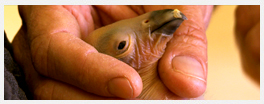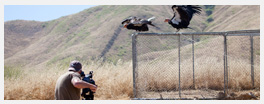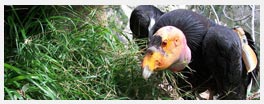Joseph Brandt
U.S. Fish & Wildlife Service Condor Recovery Program
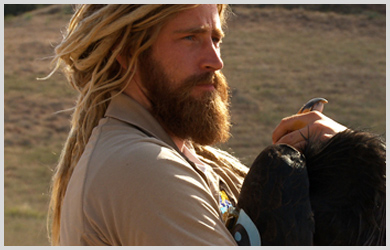
The lead field biologist for the Wildlife Service’s Condor Recovery Program, Joseph Brandt is a larger-than-life character - literally, at 6'6" he's an impressive and gregarious individual in person as well as onscreen. Passionate and at the same time pragmatic about building a self-sustaining wild condor population, Joseph is one of those exceptional individuals that relishes the gritty challenges found in biological field work. As condors never nest anywhere convenient to humans, Joseph's extensive background in rock climbing is used routinely in his job. If you ever thought it would be fun to be a biologist, you'll appreciate Joseph Brandt. A taskmaster and arguably the exact kind of personality that makes a recovery program like this one possible. Joseph shares his passion for the condor in a way that will make you appreciate the beauty of one of the rarest birds on earth. As his collaborator in the Big Sur condor recovery effort, Joe Burnett, related "...he's in it because he cares about the birds".
A graduate of the University of Oregon. Joseph has worked with grizzly bears in Montana, sea birds on the Columbia River and with penguins below the equator. He became enamored with the condor as a seasonal biologist with the Ventana Wildlife Society in Big Sur, California. After a stint in Southern Chile ("...just me, two Chileanos and one-hundred thousand penguins") he took a biologist position with the California Condor Recovery Program in 2006 and manages the field program today.
Condor 79 'Pitahsi'
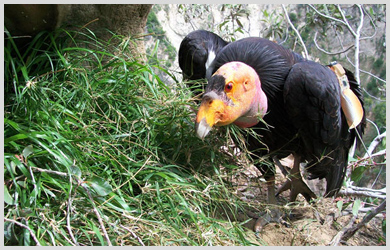 Condor 79 was given the Chumash indian name "Pitahsi" when she hatched at the LA Zoo in 1992. A bird that reveals the many and varied challenges of the recovery program, Pitahsi has a unique personality. She proves to be unusually bold in defense of her nest against the biologist's interventions. Originally released in the fall of 1992, Pitahsi was recaptured after a few short months as she engaged in behaviors that threatened her safety. Pitahsi would spend the next 12 years in the Los Angeles Zoo, where she would produce three offspring. She was finally re-released at Bitter Creek National Wildlife Refuge in November 2006. In 2008, she mated with younger male, condor 247 and has three failed nest attempts in the wild. An unfortunate side-effect of sub-lethal exposure to lead are reproductive problems in birds. While it's impossible to say that lead has caused the problem eggs laid since being released, what we can say is that she has certainly been exposed to lead repeatedly. She spent over a month in chelation treatment in December of 2011 after testing "high" during a routine trap up. Pitahsi and 247 fostered two zoo-bred chicks since 2008 including condor 599, (below) and are raising a third foster chick on the refuge today.
Condor 79 was given the Chumash indian name "Pitahsi" when she hatched at the LA Zoo in 1992. A bird that reveals the many and varied challenges of the recovery program, Pitahsi has a unique personality. She proves to be unusually bold in defense of her nest against the biologist's interventions. Originally released in the fall of 1992, Pitahsi was recaptured after a few short months as she engaged in behaviors that threatened her safety. Pitahsi would spend the next 12 years in the Los Angeles Zoo, where she would produce three offspring. She was finally re-released at Bitter Creek National Wildlife Refuge in November 2006. In 2008, she mated with younger male, condor 247 and has three failed nest attempts in the wild. An unfortunate side-effect of sub-lethal exposure to lead are reproductive problems in birds. While it's impossible to say that lead has caused the problem eggs laid since being released, what we can say is that she has certainly been exposed to lead repeatedly. She spent over a month in chelation treatment in December of 2011 after testing "high" during a routine trap up. Pitahsi and 247 fostered two zoo-bred chicks since 2008 including condor 599, (below) and are raising a third foster chick on the refuge today.
Mike Clark
Los Angeles Zoo
 Mike Clark has been with the Los Angeles Zoo for over twenty years. Originally drawn to the Zoo to work with raptors, Mike has gained an uncanny level of intimacy into the behavioral characteristics of the California condor. A funny and unbelievably dynamic character, Mike frequently contributes his knowledge of the condor to the field crews up and down the state. He may be just as likely be found on rappel into a precipitous cliff-side condor nest as he would be in the Zoo. On a single 24 hour period we witnessed him doing a nest entry in Big Sur, returning the 300 miles to LA only to board a plane bound to Boise, Idaho for an egg swap with the Peregrine Fund condor program. His energy and humor boundless, Mike is another character in the program driven by a passion to make a difference for the condor. It is Mike and his fellow keepers at the LA Zoo that bear the brunt of the difficult reality lead ammunition creates for the recovery of the California condor.
Mike Clark has been with the Los Angeles Zoo for over twenty years. Originally drawn to the Zoo to work with raptors, Mike has gained an uncanny level of intimacy into the behavioral characteristics of the California condor. A funny and unbelievably dynamic character, Mike frequently contributes his knowledge of the condor to the field crews up and down the state. He may be just as likely be found on rappel into a precipitous cliff-side condor nest as he would be in the Zoo. On a single 24 hour period we witnessed him doing a nest entry in Big Sur, returning the 300 miles to LA only to board a plane bound to Boise, Idaho for an egg swap with the Peregrine Fund condor program. His energy and humor boundless, Mike is another character in the program driven by a passion to make a difference for the condor. It is Mike and his fellow keepers at the LA Zoo that bear the brunt of the difficult reality lead ammunition creates for the recovery of the California condor.
Myra Finkelstein
Researcher, UC Santa Cruz
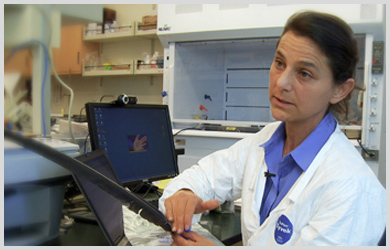 Myra Finkelstein is the lead researcher at the University of California Santa Cruz responsible for the pivotal research that definitively connects the dots between lead ammunition and lead toxicosis in condors. With a Ph.D. in environmental toxicology, Myra has significant experience in the analysis of environmental toxins and their effect on wild species. Her Ph.D. thesis detailed how the peeling lead-based paint of WW II Navy facilities led to lead toxicosis in the Southern Albatross of Midway Island. Her identification of the isotopic signatures ( also referred to as isotopic fingerprints) of lead found in the blood and feather samples of condors can be definitvely linked to the lead used in ammunition. Her research further establishes the chronic frequency and severity of lead exposure in the California condor.
Myra Finkelstein is the lead researcher at the University of California Santa Cruz responsible for the pivotal research that definitively connects the dots between lead ammunition and lead toxicosis in condors. With a Ph.D. in environmental toxicology, Myra has significant experience in the analysis of environmental toxins and their effect on wild species. Her Ph.D. thesis detailed how the peeling lead-based paint of WW II Navy facilities led to lead toxicosis in the Southern Albatross of Midway Island. Her identification of the isotopic signatures ( also referred to as isotopic fingerprints) of lead found in the blood and feather samples of condors can be definitvely linked to the lead used in ammunition. Her research further establishes the chronic frequency and severity of lead exposure in the California condor.
Listen to an interview with Myra Finkelstein discussing her 2012 study on lead poisoning in condors published in the Proceedings of the National Academy of Sciences: PNAS Science Sessions
Jan Hamber
Condor Conservationist, Santa Barbara Museum of Natural History
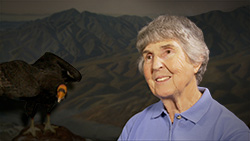 A member of the condor recovery team since the 1970's, Jan began her contribution to the field research on the California condor with naturalist, Dick Smith well prior to the inception of the federal effort to save the species. Trained as a biologist at Cornell, she today manages an archive of California condor research and field observations that dates back over a hundred years. Jan is so passionate about the restoration of the condor back within its historic range that she still volunteers with tracking of the birds in the field today. "My goal has always been to save the species..." relates Jan. She appears in The Condor's Shadow in a pivotal scene where she reads from her field observation journal and recounts the capture of the last wild condor, AC-9 on Easter Sunday in 1987. The segment is a moving testament to the underlying passion that is foundational to the entire California condor recovery program.
A member of the condor recovery team since the 1970's, Jan began her contribution to the field research on the California condor with naturalist, Dick Smith well prior to the inception of the federal effort to save the species. Trained as a biologist at Cornell, she today manages an archive of California condor research and field observations that dates back over a hundred years. Jan is so passionate about the restoration of the condor back within its historic range that she still volunteers with tracking of the birds in the field today. "My goal has always been to save the species..." relates Jan. She appears in The Condor's Shadow in a pivotal scene where she reads from her field observation journal and recounts the capture of the last wild condor, AC-9 on Easter Sunday in 1987. The segment is a moving testament to the underlying passion that is foundational to the entire California condor recovery program.
Michael Mace
Curator, San Diego Zoo's Safari Park
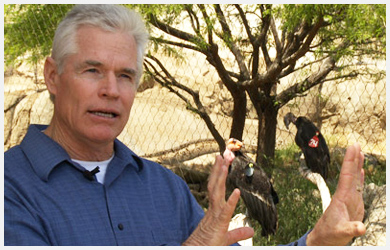 Michael Mace is curator of birds for the San Diego Zoo's Safari Park. His responsibilities include management of the Avian Department. Michael has participated in the condor recovery effort since its inception. The ground-breaking work in captive breeding of California condors fell under Mike's purvey during the early years of the program. That work continues today. From a low point of twenty two birds remaining on earth in the 1980's, captive breeding has resulted in a population of over 400 birds today. The master database for every condor on earth (the condor "Studbook") is managed by Michael and his team at the Safari Park.
Michael Mace is curator of birds for the San Diego Zoo's Safari Park. His responsibilities include management of the Avian Department. Michael has participated in the condor recovery effort since its inception. The ground-breaking work in captive breeding of California condors fell under Mike's purvey during the early years of the program. That work continues today. From a low point of twenty two birds remaining on earth in the 1980's, captive breeding has resulted in a population of over 400 birds today. The master database for every condor on earth (the condor "Studbook") is managed by Michael and his team at the Safari Park.
Bruce Rideout, Ph.D, DVM
Zoological Society of San Diego
Bruce Rideout, Ph.D. DVM is a pathologist and disease-investigation specialist for the Zoological Society of San Diego (San Diego Zoo and San Diego Safari Park). He is board certified in the specialty of veterinary pathology. Dr. Rideout came to the Zoological Society of San Diego in 1991, where he is now head of the Wildlife Disease Laboratories and associate director of conservation and research for endangered species. In the film, Dr. Rideout provides a window into the source and effect of lead on condors. His department's responsibilities for the Zoological Society of San Diego is to conduct post-mortem necropsy on condors that have died both in the Zoo's and in the field. His conclusion after 20+ years of working with condors is that the vast majority of birds who have died from lead exposure have succumbed to it after exposure to spent lead ammunition. Other plausible sources of lead include lead paint but none other than lead ammunition has ever been discovered to have directly resulted in a condor death.
Condor 247
Condor 247 hatched at the San Diego Safari Park in August of 2002. He came of age quickly and has shown himself to be a dominant male in Southern California flock. This dominance has proved itself to be worthwhile with his courtship and pairing with the much older female Pitahsi. Mated with Pitahsi in late 2007, the pair have fostered three chicks in the wild including condor 599, featured in the film.
Condor 599
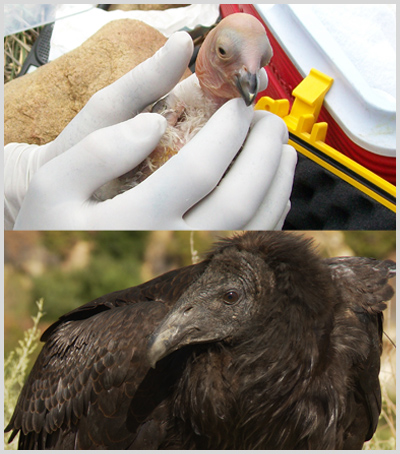 Condor 599 is the foster chick of condors 247 and 79 - AKA "Pitashsi". In the film we follow this chick over the first year of her life. From
a one day old chick hatched at the LA Zoo through to fledgingin the fall it's a remarkable evolution over the nine month nesting season. Even more remarkable with this bird given that she began life at the Zoo before being "hatched again" in a nest cavity on a mountainside. A compelling window into the do-all-possible passion that goes into rebuilding a self-sustaining population of the California condor.
Condor 599 is the foster chick of condors 247 and 79 - AKA "Pitashsi". In the film we follow this chick over the first year of her life. From
a one day old chick hatched at the LA Zoo through to fledgingin the fall it's a remarkable evolution over the nine month nesting season. Even more remarkable with this bird given that she began life at the Zoo before being "hatched again" in a nest cavity on a mountainside. A compelling window into the do-all-possible passion that goes into rebuilding a self-sustaining population of the California condor.
Connect with Us!
![]()
background
Learn about the history of the California Condor here.
![]()
filmmakers
See the crew here.
![]()
the story
Click here to see more.
